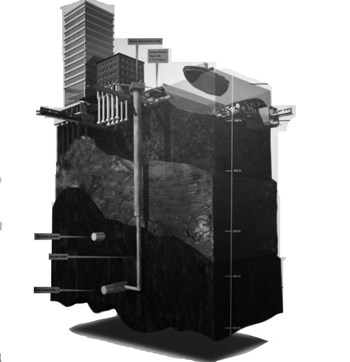
New York is often called a “vertical” city because its finite borders impose strict limits on expansion. In Manhattan particularly, the only way to build is up. This verticality goes both ways, however—for all the towering skyscrapers aboveground, there’s an equally vast and Byzantine system of structures below the pavement. Gotham’s undercarriage is a honeycomb of steam tunnels, sewage mains, disused subway stations, and odd, empty spaces that city workers simply call “voids”—some of which are accessible to the public, some of which have been locked or sealed up for decades.
A steam tunnel beneath Atlantic Avenue in Brooklyn, for example, was sealed during the Civil War for purposes of defense, and remained that way until its discovery by a City College engineering student in 1981—a subterranean highway, lost for more than a century.
There is a vast chamber under Central Park the size of the Sistine Chapel, where the sodium vapor lamps never go out. There are tunnels beneath Columbia University and the New York Public Library. A warren of unmapped passages can supposedly be found in the bowels of Chinatown, according to Herbert Asbury, a journalist and true crime writer, who is known for penning The Gangs of New York among other works. And Al Capone reportedly tunneled beneath the city like a mole, although tales of Capone and secret vaults are of questionable veracity. (Just ask Geraldo Rivera.)
There are more than 100 miles of steam pipes and a hundred times that many miles of sewer pipes serving New York City. There are also subway tunnels of course—some of which are disused or abandoned—as well as wires for telephony and electricity, and deep beneath it all, three enormous pipes that carry the city’s water supply from upstate.
What you won’t find beneath the city are alligators. That’s an urban legend—but a fable that has a bit of veracity behind it.
Overhead to Underground
In 1876, Alexander Graham Bell won a patent for the telephone. It took less than a decade for the newfangled gizmo to make its mark on the city. Between the wires and the ubiquitous clotheslines, the city streets were practically in the shade. The poles were so ugly and cumbersome that a law was enacted banning them. The law was ignored in typical Tammany Hall fashion, but Mother Nature held with the lawmakers, enforcing the prohibition with Biblical wrath after the great blizzard in March 1888 toppled most of the lines. After that, the wires went underground. They had plenty of company—and would soon have much more.
Down in the Sewers
The first modern contrivance placed beneath Manhattan was a sewer—a simple channel beneath Broad Street, engineered when the city was still New Amsterdam. The idea was to pump raw sewage into the lower Hudson River, a practice that incredibly enough only ended in 1986. Sewage pipes were sunk piecemeal around the city, their construction spurred on by rapid population growth— and cholera outbreaks in the 1840s caused by human waste-contaminated drinking water. The city began building sewers in earnest the following decade. In fact, some of the sewer pipes still serving Lower Manhattan predate the Civil War.
Because so many different pipes were already underground—and because at the time, pumping sewage out seemed less important in the grand scheme of things than pumping clean water in, sewer planning in the city was less well thought-out than, say, the design of the Croton Aqueduct upstate. “The most significant distinction between water supply and sewerage was the very conception of the services,” writes Joanne Abel Goldman in her history, Building New York’s Sewers. “While the Croton Aqueduct was conceived of as a system from its inception, sewers continued to be viewed as individual conduits…Lacking any rational mode of integration, the effectiveness of these public works deteriorated.”
By the time Abraham Lincoln spoke at the Cooper Union, there were already some 70 miles of sewer pipe beneath Manhattan. There is now more than 100 times that.
Water, Water Everywhere
Even before the first Europeans settled on Manhattan Island in the seventeenth century, the water supply was sketchy. Croton Lake, a reservoir created by damming the Croton River some 40 miles upriver from Manhattan, was completed in 1842. The Croton Aqueduct, a complex system that relied on gravity to flow clean water into the city, was constructed at the same time. Water emptied primarily into two main reservoirs in Manhattan: one at what is now the Great Lawn of Central Park, the other at the current location of the New York Public Library.
A second water system, this one originating in the Catskills (where several towns were razed to create the Ashokan Reservoir) began operation in 1924. The Catskills system links with the Kensico Reservoir in Westchester before making its way to New York City.
Aside from the 6,600 miles of pipe that convey water to the buildings, the main water conduits for clean water to the city are known as Water Tunnels Number 1 and 2, completed in 1917 and 1936, respectively. These are massive tubes, 24 feet across, sunk hundreds of feet below the surface.
But they are old, and they leak, and closing the valves poses enormous challenges. For one thing, repairing a water tunnel is not like changing a light bulb.
“You don’t just turn it off, fix it, and turn it on the next day,” says Kevin Bone, an architect with Bone Levine, a professor of architecture at the Cooper Union, and the co-author of a definitive history of New York’s water supply. “You have to ‘de-water’ it. At the very least, you’re talking months and months.”
Then there are mechanical issues.
“If they shut one of those valves, there’s concern that there will be a valve problem,” explains “It’s not that it’s not there; it’s that it hasn’t been used.”
Any time you touch something mechanical that hasn’t been budged in a century, things can go awry. The precarious condition of the water tunnels is perhaps the gravest infrastructure threat to New York City.
“If one of the underground aqueducts failed to operate, I’m not sure what their plan is,” Bone says, referring to the Department of Environmental Protection (DEP), which would be the responsible agency. “We’d have much less water to function with, that’s for sure.”
The urgency of the situation spurred officials to begin construction of a third water tunnel. Planning began in the 1950s, and work commenced in 1970. While Stage One of the project—a 13-mile-long, concrete-lined tube more than 20 feet wide blasted through bedrock as deep as 800 feet below street level, from Yonkers through Upper Manhattan to Astoria—was completed in 1998, the estimated completion date for the rest of the project has been pushed back from 2012 to 2015 and now to 2020.
Gas, Steam & Electricity
The New York Gas Light Company was founded way back in 1823. In the years that followed, gas lines were installed throughout Lower Manhattan. Subsequent expansions in the following decades laid pipe throughout the borough.
Toward the end of the 19th century, the wonderfully-named inventor Birdsill Holly developed a way to heat his house with steam—in 1877, he formed a company to expand the service. Holly’s company was soon taken over by Wallace C. Andrews, and by 1882, the New York Steam Company was laying pipes and tubes all across Lower Manhattan. Within four years, the company had hundreds of clients and some five miles of mains. The popularity of steam surged—gathered steam, if you will—after the aforementioned blizzard of ’88 did not interrupt service. By the early 1930s, nearly every landmark building in New York—Grand Central Station, the Empire State Building, the Chrysler Building, Rockefeller Center, and so forth—was hooked on steam.
Concurrently, Thomas Edison’s electric company was expanding operations all across Manhattan—the lights were turned on, literally and figuratively, at 3 p.m. on September 4, 1882. Not surprisingly, Edison saw the value in underground conduits, and had his wires buried in the ground.
The New York Gas Light Company, the Edison Company, and the New York Steam Company—as well as several other smaller outfits—were eventually integrated into the Consolidated Edison Company, or Con Ed. Today, Con Ed maintains over 4,000 miles of gas lines, 100 miles of steam pipes and mains, and a staggering 94,000 miles of underground electrical cables.
“Obviously, working on the underground in Manhattan can be a challenge any day or season,” says Con Ed Steam spokesperson Allan Drury. “Traffic volume poses potential dangers to our employees who maintain and upgrade the steam system—but they are professionals whose number-one priority is their safety and customers’ safety.
Drury says that Con Ed isn’t merely maintaining existing lines—they’re building new ones as well. “We plan on replacing the old, oil-fired boilers at theHudson Avenue generatingplant with a state-of-the-art, four-boiler, gas-fired/dual-fuel steam generating plant,” he says. “The new plant will be builtnext to the existing plant within the existing complex, and will burn natural gas instead of oil to generate steam. We hope to begin construction in late 2010 and have the new steam plant operationalby late 2013.”
According to Drury,“More than 50 percent ofthe steam supplied by Con Edison is produced through clean cogeneration technology. As a result, we avoid the release of 1.5 million tons of CO2 ayear compared with traditional electric and steam production methods.”
The Subway
While elevated lines date to just after the Civil War, the first subway was not built in New York until after the consolidation of the five boroughs in 1898. The city financed the massive project itself, issuing rapid-transit bonds to raise the needed funds. The Interborough Rapid Transit Company—better known by its initials, IRT—was enlisted to manage the actual trains. This was logical, because the IRT was, at the time, the most successful operator of the elevated lines.
The first line, running from City Hall to the Bronx, opened in 1904. The city signed contracts with both IRT and Brooklyn Rapid Transit, and lines continued to pop up. The Eighth Avenue line, which ran from Washington Heights to the World Trade Center area, opened in September of 1932. In 1940, the city assumed control of the IRT and BRT, and in 1953, the Metropolitan Transit Authority, or MTA, was born.
Although the New York City subway system is a marvel of urban planning, competition among the early pioneers led to overlapping networks. Thus, there remain a number of abandoned subway tunnels scattered about, mostly in Lower Manhattan.
The IRT maintained a line beneath Second Avenue that was shut down during the Second World War. The east side has fewer lines than the west side, so plans were made to expand this Second Avenue line in 1951. A $500 million bond was issued at the time specifically for this purpose, but it was spent on other, less ambitious projects. The federal government funneled more money into the project in the 1960s; over a billion dollars was spent constructing several tunnels beneath Second Avenue, but work ceased during the fiscal crisis in 1975.
On April 23, 2007, work finally picked up on the long-promised Second Avenue subway line. According to MTA spokesperson Kevin Ortiz, “The scope of the project is amazingly complex, but in actuality, the technology that’s available at this point expedites the process, although you still have your challenges. The current plan is for the project to be completed in four phases. We’re in the process of Phase One. Once that is completed, it is estimated to carry 200,000 weekday riders a day, easing congestion on the Lexington Avenue line. We’re hoping by September of 2016, you’ll be able to ride between 63rd and 125th Streets.”
Founding a new subway line is an incredibly difficult task—even with modern technology and equipment, the logistical considerations of such a project are staggering, thanks in large part to the subterranean structures discussed in this very article.
According to Joseph Trainor, a senior vice president and chief engineer with the MTA Capital Construction Company for nearly two decades, technology has needless to say, come a long way.
“Certainly, tunnel boring machines give us the ability to mine underground now, whereas before— except when we went under rivers—most of it was open cut; basically a gigantic trench in the street,” Trainor says. “The thing that was simpler back then, and which modern technology still can’t really overcome, is the city is now so vast, and has grown upward to such an extent that whenever we have to dig up a street now, we encounter every manner of utility. Of course, there are ways of using instruments to map utilities underground—which is O.K. if you’re operating in Peekskill or someplace upstate, but when you have a spaghetti bowl of utilities like we have, it’s hard to differentiate through the various layers of what’s where and what’s what. So those systems don’t often work.”
On the upside however, “From one point of view, the work is a lot safer than it used to be,” says Trainor. “Nowadays, safety is a watchword. We have old photographs in our offices of the men who constructed the subways years ago; nobody wore vests or hard hats. Nobody wore helmets, safety glasses or earplugs.”
The Artifact of the Matter
In addition to the utility “spaghetti bowl,” whenever excavation is done in the city for any reason—new subway lines, infrastructure repairs, or new building construction—history has a tendency to assert itself, thanks to the layers upon layers of detritus and effluvia left by successive generations of New Yorkers. Excavation crews regularly uncover artifacts ranging from old coins and glassware to human bones and teeth. To insure that any historically significant artifacts are properly catalogued and preserved, archaeologists are routinely hired by city agencies to assess what’s uncovered and make sure it’s handled respectfully and appropriately.
According to Trainor, during the South Ferry project his organization was working on in Lower Manhattan, an old section of stone wall was uncovered. A private archaeology firm brought in to excavate, photograph, catalog, and remove the stones, which were incorporated into a Parks Department display at Castle Clinton. Eventually, it was decided that enough of the wall had been removed and reassembled, and Trainor’s crews were able to merely remove the rest as debris and move the project forward.
When crews come across human remains, the situation is a little different. “We found bones and a skull [during the same project],” says Trainor, “and when that happens, when you find body parts, the first call goes to the medical examiner’s office. So the first time we found bones, the cop cars converged—it was like a crime scene. It was determined that the bones were of an elderly man, and the other was from a teenage boy. All that Battery Park land is ‘fill.’ So those bones might have been picked up from a cemetery in Queens a hundred years ago to provide fill. But in any event, we’ve found coins, clay pipes, buckles. It all goes into the hands of an archivist. There is a section of the Battery Wall that is also displayed at the foot of the escalator in the main entry point for the South Ferry Station, right outside the ferry terminal.”
It’s a Croc
Although there are a great many unusual things to be found under the sidewalks of New York City, and the odd myth persists, there are no alligators beneath the streets of Manhattan—just retired sewer inspectors with active imaginations and a propensity for exaggeration. Nor is there much in the way of secret passages and the like—not that anyone knows about, anyway.
“I now think that there isn’t a secret tunnel expert in New York because most of the secret tunnels one hears about are fictitious or have been destroyed or sealed up and that not enough remain to support a hobby,” concludes Alan Wilkinson—the de facto secret tunnel expert—in a piece in The Believer.
Either that or the guy was eaten by alligators.
Greg Olear is a freelance writer and a frequent contributor to The Cooperator.
Editor’s Note: The MTA’s exhibit “The Future Beneath Us: Eight Great Projects Under New York” has been extended through November 1st at the Transit Museum Gallery Annex and NYPL Science Business & Industry Library, 188 Madison Avenue.






Comments
Leave a Comment